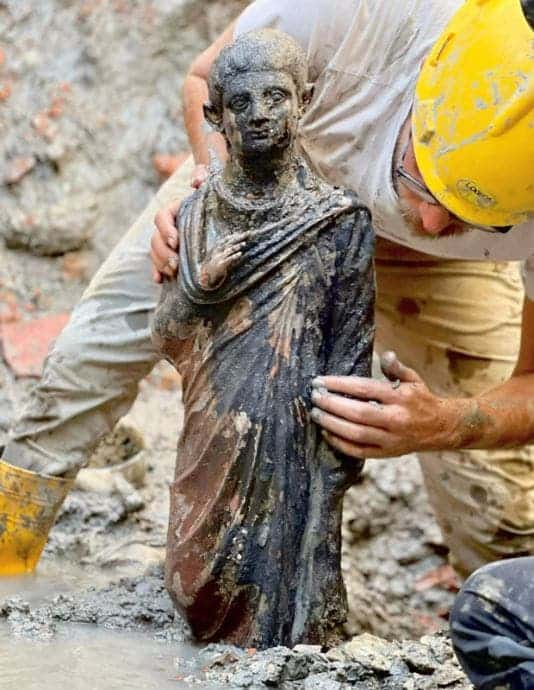An incredible find at an ancient spa — archeologists working in Tuscany, Italy, have unearthed 24 bronze statues that are over 2,300 years old. The artifacts coincide with a power transition in the area, from the indigenous Etruscans to the conquering Romans.

Many words pop into one’s mind when thinking of a spa; “baths”, “relaxation”, and maybe even “exfoliation”. That being said, not many of us would think of “archeologists digging in the mud” as something that we’d expect to see at the spa. But, at one millennia-old bath in Tuscany, that’s exactly what you will find.
They are hard at work excavating an “exceptional” find: a treasure trove of 24 bronze statues that have been lying for thousands of years buried in the mud and boiling springwater covering the ancient baths. The complex was initially built by the Etruscans, but was later expanded upon and further decorated after the Roman Republic took over the area.
Fancy self-care
“It is certainly one of the most significant discoveries of bronzes in the history of the ancient Mediterranean,” Massimo Osanna, the director general of museums at the Italian culture ministry, told the Italian news agency Ansa.
The Etruscans were an Italian people that fostered a thriving civilization and vibrant culture in the lands that form today’s regions of Tuscany and Umbria in central Italy. They lived there quite happily for around 500 years until they were conquered by the expanding Roman Republic. Despite this, their legacy lived on, as Etruscan customs had a pronounced influence on Rome’s culture and artistic preferences.
Such influence is spectacularly showcased by the 24 recently-unearthed statues.
The statues were discovered partially submerged in the mud around a famous ancient bath. Built at San Casciano dei Bagni, near Siena, the bath complex took advantage of natural hot, mineralized springs which were highly-valued for their medicinal properties in the Roman Empire. Even today, the site is close to one of Italy’s most popular spa destinations.
It is believed that the site, including the spa area, fountains, and religious altars, was first built by the Etruscans around the 3rd century BC. They were expanded on under the Roman Republic and Empire, reflecting their growing popularity at the time. Even emperors, such as Augustus, frequented the baths for their therapeutic benefits — the hot springs here bubbled up water rich in minerals such as calcium and magnesium.
The site remained in use until the fifth century and was closed down after Christianity became the official religion of Rome. The pools were sealed with stone pillars and the statues lining the buildings were thrown in the pools.
Luckily for us, they preserved excellently. The find includes 24 statues and is considered to be one of the most significant of its kind in a few decades. The statues include such personae as Hygeia, the goddess of health and cleanliness, with a snake coiling around her arm. This is the goddess from whose name we get the word “hygiene”. The god Apollo is also represented, alongside mortals such as emperors, matrons, and children.
Five of the statues are almost one meter tall, while the others were smaller in size. Archaeologists working at the site have also discovered Latin and Etruscan inscriptions, as well as thousands of coins in the pools. Visitors at the site likely threw coins into the baths to wish for health and good luck — as remains the custom in Italy.
According to Osanna, this is the most significant discovery of bronze statues in Italy since 1972, when two full-sized Greek statues, showcasing naked, bearded warriors, were found near Riace.
Preliminary analysis of the newly-found statues suggests that they were manufactured locally, between the second and first centuries BC. They were likely initially owned by local elites or lords and, later on, Roman landlords, wealthy families, or emperors.
They captured an important time period in local history, when power was passed between the Etruscans and Romans. This transition was violent, but the bats are completely devoid of any signs of combat. The site was likely spared conflict both due to its springs, but also the religious value it held.
“Even in historical epochs in which the most awful conflicts were raging outside, inside these pools and on these altars the two worlds, the Etruscan and Roman ones, appear to have coexisted without problems,” said Jacopo Tabolli, the archaeologist that has been leading excavations at the site since 2019.


